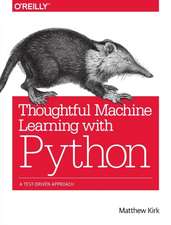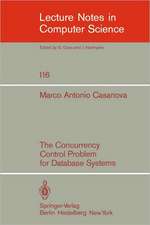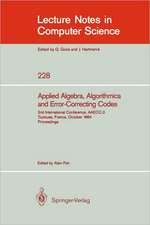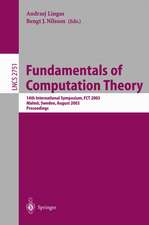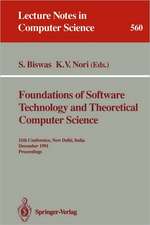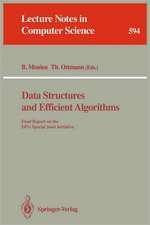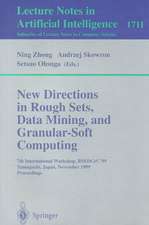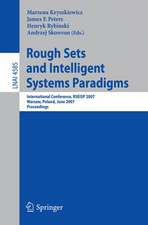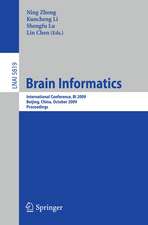Rough Sets and Current Trends in Computing: Third International Conference, RSCTC 2002, Malvern, PA, USA, October 14-16, 2002. Proceedings: Lecture Notes in Computer Science, cartea 2475
Editat de James J. Alpigini, James F. Peters, Andrzeij Skowron, Ning Zhongen Limba Engleză Paperback – 25 sep 2002
Din seria Lecture Notes in Computer Science
- 20%
 Preț: 1061.55 lei
Preț: 1061.55 lei - 20%
 Preț: 307.71 lei
Preț: 307.71 lei - 20%
 Preț: 438.69 lei
Preț: 438.69 lei - 20%
 Preț: 645.28 lei
Preț: 645.28 lei -
 Preț: 410.88 lei
Preț: 410.88 lei - 15%
 Preț: 580.46 lei
Preț: 580.46 lei - 17%
 Preț: 427.22 lei
Preț: 427.22 lei - 20%
 Preț: 596.46 lei
Preț: 596.46 lei -
 Preț: 449.57 lei
Preț: 449.57 lei - 20%
 Preț: 353.50 lei
Preț: 353.50 lei - 20%
 Preț: 1414.79 lei
Preț: 1414.79 lei - 20%
 Preț: 309.90 lei
Preț: 309.90 lei - 20%
 Preț: 583.40 lei
Preț: 583.40 lei - 20%
 Preț: 1075.26 lei
Preț: 1075.26 lei - 20%
 Preț: 310.26 lei
Preț: 310.26 lei - 20%
 Preț: 655.02 lei
Preț: 655.02 lei - 20%
 Preț: 580.93 lei
Preț: 580.93 lei - 20%
 Preț: 340.32 lei
Preț: 340.32 lei - 18%
 Preț: 938.83 lei
Preț: 938.83 lei - 20%
 Preț: 591.51 lei
Preț: 591.51 lei - 15%
 Preț: 438.59 lei
Preț: 438.59 lei - 20%
 Preț: 337.00 lei
Preț: 337.00 lei -
 Preț: 389.48 lei
Preț: 389.48 lei - 20%
 Preț: 607.39 lei
Preț: 607.39 lei - 20%
 Preț: 1024.44 lei
Preț: 1024.44 lei - 20%
 Preț: 579.30 lei
Preț: 579.30 lei - 20%
 Preț: 763.23 lei
Preț: 763.23 lei - 20%
 Preț: 453.32 lei
Preț: 453.32 lei - 20%
 Preț: 575.48 lei
Preț: 575.48 lei - 20%
 Preț: 585.88 lei
Preț: 585.88 lei - 20%
 Preț: 825.93 lei
Preț: 825.93 lei - 20%
 Preț: 763.23 lei
Preț: 763.23 lei - 17%
 Preț: 360.19 lei
Preț: 360.19 lei - 20%
 Preț: 1183.14 lei
Preț: 1183.14 lei - 20%
 Preț: 340.32 lei
Preț: 340.32 lei - 20%
 Preț: 504.57 lei
Preț: 504.57 lei - 20%
 Preț: 369.12 lei
Preț: 369.12 lei - 20%
 Preț: 583.40 lei
Preț: 583.40 lei - 20%
 Preț: 343.62 lei
Preț: 343.62 lei - 20%
 Preț: 350.21 lei
Preț: 350.21 lei - 20%
 Preț: 764.89 lei
Preț: 764.89 lei - 20%
 Preț: 583.40 lei
Preț: 583.40 lei - 20%
 Preț: 649.49 lei
Preț: 649.49 lei - 20%
 Preț: 341.95 lei
Preț: 341.95 lei - 20%
 Preț: 238.01 lei
Preț: 238.01 lei - 20%
 Preț: 538.29 lei
Preț: 538.29 lei
Preț: 663.29 lei
Preț vechi: 829.10 lei
-20% Nou
Puncte Express: 995
Preț estimativ în valută:
126.92€ • 132.87$ • 105.02£
126.92€ • 132.87$ • 105.02£
Carte tipărită la comandă
Livrare economică 05-19 aprilie
Preluare comenzi: 021 569.72.76
Specificații
ISBN-13: 9783540442745
ISBN-10: 354044274X
Pagini: 660
Ilustrații: XVI, 644 p.
Dimensiuni: 155 x 235 x 35 mm
Greutate: 0.91 kg
Ediția:2002
Editura: Springer Berlin, Heidelberg
Colecția Springer
Seriile Lecture Notes in Computer Science, Lecture Notes in Artificial Intelligence
Locul publicării:Berlin, Heidelberg, Germany
ISBN-10: 354044274X
Pagini: 660
Ilustrații: XVI, 644 p.
Dimensiuni: 155 x 235 x 35 mm
Greutate: 0.91 kg
Ediția:2002
Editura: Springer Berlin, Heidelberg
Colecția Springer
Seriile Lecture Notes in Computer Science, Lecture Notes in Artificial Intelligence
Locul publicării:Berlin, Heidelberg, Germany
Public țintă
ResearchCuprins
Keynote Papers.- In Pursuit of Patterns in Data Reasoning from Data - The Rough Set Way.- Toward a Theory of Hierarchical Definability (THD).- Plenary Papers.- Modelling Biological Phenomena with Rough Sets.- Database Mining on Derived Attributes Granular and Rough Computing Approach.- A Proposed Evolutionary, Self-Organizing Automaton for the Control of Dynamic Systems.- Rough Set Analysis of Preference-Ordered Data.- Fuzzy Sets, Multi-valued Mappings, and Rough Sets.- Foundations and Methods I.- Investigating the Choice of l and u Values in the Extended Variable Precision Rough Sets Model.- A Quantitative Analysis of Preclusivity vs. Similarity Based Rough Approximations.- Heyting Wajsberg Algebras as an Abstract Environment Linking Fuzzy and Rough Sets.- Dominance-Based Rough Set Approach Using Possibility and Necessity Measures.- Generalized Decision Algorithms, Rough Inference Rules, and Flow Graphs.- Generalized Rough Sets and Rule Extraction.- Towards a Mereological System for Direct Products and Relations.- On the Structure of Rough Approximations.- Modification of Weights of Conflict Profile’s Elements and Dependencies of Attributes in Consensus Model.- Reasoning about Information Granules Based on Rough Logic.- Foundations and Methods II.- A Rough Set Framework for Learning in a Directed Acyclic Graph.- On Compressible Information Systems.- Functional Dependencies in Relational Expressions Based on Or-Sets.- On Asymptotic Properties of Rough— Set— Theoretic Approximations. Fractal Dimension, Exact Sets, and Rough Inclusion in Potentially Infinite Information Systems.- About Tolerance and Similarity Relations in Information Systems.- Rough Sets, Guarded Command Language, and Decision Rules.- Collaborative Query Processing in DKS Controlled by Reducts.- ANew Method for Determining of Extensions and Restrictions of Information Systems.- A Logic Programming Framework for Rough Sets.- Attribute Core of Decision Table.- Foundations and Methods III.- Signal Analysis Using Rough Integrals.- How Much Privacy? — A System to Safe Guard Personal Privacy while Releasing Databases.- Rough Clustering: An Alternative to Find Meaningful Clusters by Using the Reducts from a Dataset.- Concept Learning with Approximation: Rough Version Spaces.- Variable Consistency Monotonic Decision Trees.- Importance and Interaction of Conditions in Decision Rules.- Time Complexity of Rough Clustering: GAs versus K-Means.- Induction of Decision Rules and Classification in the Valued Tolerance Approach.- Time Series Model Mining with Similarity-Based Neuro-fuzzy Networks and Genetic Algorithms: A Parallel Implementation.- Granular and Neuro Computing.- Closeness of Performance Map Information Granules: A Rough Set Approach.- Granular Computing on Binary Relations Analysis of Conflict and Chinese Wall Security Policy.- Measures of Inclusion and Closeness of Information Granules: A Rough Set Approach.- Rough Neurocomputing: A Survey of Basic Models of Neurocomputation.- Rough Neurocomputing Based on Hierarchical Classifiers.- Using Granular Objects in Multi-source Data Fusion.- Induction of Classification Rules by Granular Computing.- Probabilistic Reasoning.- Acquisition Methods for Contextual Weak Independence.- A Method for Detecting Context-Specific Independence in Conditional Probability Tables.- Properties of Weak Conditional Independence.- A Proposal of Probability of Rough Event Based on Probability of Fuzzy Event.- Approximate Bayesian Network Classifiers.- Accuracy and Coverage in Rough Set Rule Induction.- Statistical Test for Rough SetApproximation Based on Fisher’s Exact Test.- Triangulation of Bayesian Networks: A Relational Database Perspective.- Data Mining, Machine Learning, and Pattern Recognition.- A New Version of Rough Set Exploration System.- Local Attribute Value Grouping for Lazy Rule Induction.- Incomplete Data Decomposition for Classification.- Extension of Relational Management Systems with Data Mining Capabilities.- Reducing Number of Decision Rules by Joining.- Scalable Classification Method Based on Rough Sets.- Parallel Data Mining Experimentation Using Flexible Configurations.- An Optimization of Apriori Algorithm through the Usage of Parallel I/O and Hints.- Patterns in Information Maps.- Discernibility Matrix Approach to Exception Analysis.- Gastric Cancer Data Mining with Ordered Information.- Web Mining.- A Granular Approach for Analyzing the Degree of Affability of a Web Site.- Comparison of Classification Methods for Customer Attrition Analysis.- User Profile Model: A View from Artificial Intelligence.- Mining the Client’s Life Cycle Behaviour in the Web.- PagePrompter: An Intelligent Web Agent Created Using Data Mining Techniques.- VPRSM Approach to WEB Searching.- Applications I.- Rough Set Approach to the Survival Analysis.- The Identification of Low-Paying Workplaces: An Analysis Using the Variable Precision Rough Sets Model.- A Search for the Best Data Mining Method to Predict Melanoma.- Towards the Classification of Musical Works: A Rough Set Approach.- Segmentation of Medical Images Based on Approximations in Rough Set Theory.- Adaptive Robust Estimation for Filtering Motion Vectors.- Rough Set Feature Selection and Diagnostic Rule Generation for Industrial Applications.- Applications II.- ?-Connected Approximations for Rough Sets.- Adaptive ClassifierConstruction: An Approach to Handwritten Digit Recognition.- The Application of Support Diagnose in Mitochondrial Encephalomyopathies.- Obstacle Classification by a Line-Crawling Robot: A Rough Neurocomputing Approach.- Rough Neural Network for Software Change Prediction.- Handling Spatial Uncertainty in Binary Images: A Rough Set Based Approach.- Evolutionary Algorithms and Rough Sets-Based Hybrid Approach to Classificatory Decomposition of Cortical Evoked Potentials.- Rough Mereological Localization and Navigation.
Caracteristici
Includes supplementary material: sn.pub/extras






